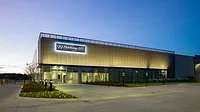Facilities go beyond green
Developed by the United States Green Building Council (USGBC), LEED provides independent, third-party verification that a building, home or community was designed and built using strategies aimed at achieving high performance in key areas of human and environmental health including the following aspects: sustainable site development, water savings, energy efficiency, material selection and indoor environmental quality, the USGBC states. The council updates the goals for LEED certification every few years and recently postponed the release of the updated LEED v4 standards to allow its stakeholders to fully build out the credit documentation, forms and education, according to the USGBC’s website.
“LEED is a leading-edge system that certifies the greenest-performing buildings in the world and addresses the complete lifecycle of buildings,” explains Tony Lamell, vice president of Stellar, Jacksonville, Fla. “In recognition of a quality building, it also addresses environmental stewardship. There are lower operating costs for the user. There’s increased asset value. Particularly for beverage users, there’s reduced waste and conservation of energy and water. It provides a healthier and safer environment for the occupants.”
Lloyd Snyder, vice president and beverage market leader for Woodard & Curran, Portland, Maine, cautions that pursuit of LEED certification will require a monetary investment.
“There’s really a cost-benefit type of discussion that needs to happen with a company,” he says. “If they’re looking to do just a water and energy type of product, you don’t necessarily need to do LEED, but if you’re looking for something to highlight and show that you’ve achieved a goal as more of a public and client relationships type of project, that weighs into the decision.”
For those considering the path to certification, Stellar’s Lamell notes that the USGBC maintains stringent standards for certification.
“LEED has a council with emphasis on leadership — they want to lead,” Lamell says. “By their nature, LEED is always steps ahead of the norm, i.e. the present building codes or standards. As building codes and standards try to match LEED, LEED tries to reinvent itself and go above the building codes and standards.”
Application variety
Woodard & Curran has worked with clients in pursuit of LEED certification for new offices as well as facility expansions, Snyder notes. Key elements of beverage projects have included on-site co-generation of energy, rainwater harvesting, drought-resistant landscaping plans, energy-efficient lighting, and mechanical heating, venting and air conditioning (HVAC) designs, he explains.
Through the years, Stellar has seen LEED certification move from office buildings into production facilities, Lamell says. One Stellar-engineered LEED-certified building is the Nestlé beverage production plant in Anderson, Ind. The plant’s sustainable features include economizers and restrictions on exhaust emissions for mechanical systems, boiler units and an HVAC and refrigeration system designed for low-emission operation, according to Stellar. In addition, Nestlé and Stellar use mostly chilled water and very little ammonia as refrigerants; 90 percent of the building is made of recycled content; and skylights are used to capture daylight with artificial lighting inside the facility adjusting to natural sunlight levels, according to Stellar. A wastewater treatment plant on the property treats wastewater from the building that is recycled and used as cooling water for the refrigeration systems, Stellar notes. The company also worked with Starbucks to achieve 2009 LEED certification for its coffee roasting and packaging plant in Gaston, S.C.
“We have our own engineering professionals on staff and our mechanical, electrical, plumbing and refrigeration engineers have a first-hand working knowledge of the model requirements, of the material considerations and those types of things,” Lamell explains. “We can certainly help assist the owner in that in a very quick manner.”
Water conservation is one of the key touch-points for LEED certification in beverage plants, suppliers note. The certification process includes many elements of water use reclamation, re-use and sourcing, Woodard & Curran’s Snyder explains.
“One of the benefits of that is that it helps take probably a core function within beverage-makers and helps you focus environmental benefits on the way you use water within your facility and the way you optimize your water processes,” he says. “A lot of beverage-makers use it also for their clients — a lot of clients are asking them to be more environmentally sustainable and, therefore, they’re getting pushed into trying to create environmentally sustainable processes within their facilities.”
Another firm that specializes in green design, Power Engineers, a member of the USGBC, features a staff of engineers and designers who have years of experience working in operations, maintenance and management positions within a variety of food and beverage sectors. In addition, last year the Hailey, Idaho-based company acquired Minnesota-based Food Systems Design and the Professional Design Group, which expanded the company’s expertise in the segment. BI
Looking for a reprint of this article?
From high-res PDFs to custom plaques, order your copy today!





